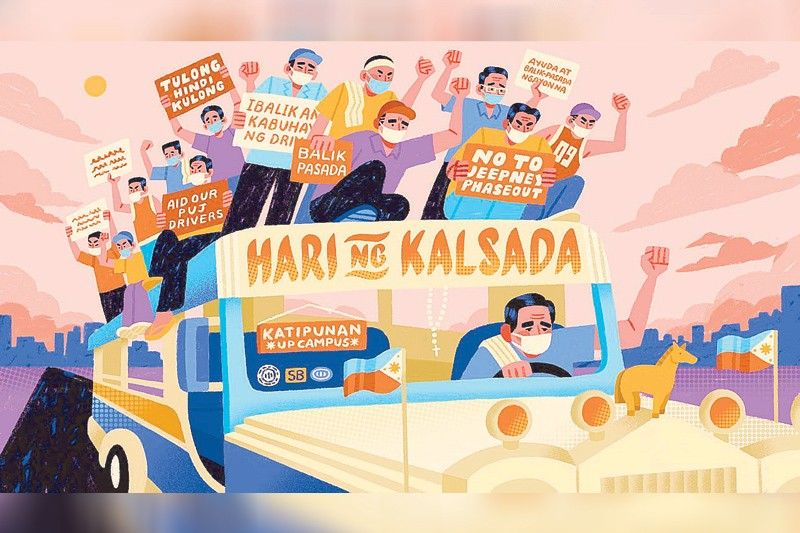Driving a downhill road

The jeepney is deeply ingrained in our culture and way of life. This stainless-steel vehicle decorated with hand-painted pop art and inscriptions of a driver’s individual identities has become an indispensable part of our transportation system. It’s not easy on the eyes — not with the kitschy illustrations adorning its body and bumpers and the rolled-up plastic covers hanging from its windows but this ubiquitous vehicle has now become an extension of our urban landscape.
It’s impossible to count the number of times we have braved the Metro Manila traffic, but I’m struck by the image of seemingly warzone-like roads on days counting down to holidays, payday Fridays, and during rush hours where a storm of passengers wrestle for rides on an already packed jeep, all while exhausted from a day’s work.
That’s how it’s always been. The masses rely heavily on jeepneys to get where they need to be because it’s always been three things: accessible, affordable and efficient.
Arguably, the jeepney is not the most comfortable mode of mass transportation; you’re cramped with other passengers all breaking a sweat while seated on cracked leather seats, but it’s undoubtedly reliable for the everyday Filipino. And behind the wheel, there’s usually a man with a towel over his shoulder, fingernails stained with grease and dirt, and a worn-out shirt to keep cool from the heat as he calls for passengers day in and day out.
And this image is not just limited to our roads. We see the jeepney represented in souvenir keychains, printed on shirts for tourists, and in makeshift replicas in galleries and exhibits proudly bannering the pride of this country. Tourists even ride jeepneys as a form of adventure and a way of immersing in our culture, and it’s also turned into a unique Filipino experience. In the opening ceremony of the 2019 SEA Games, Hotdog’s Manila with its lyrics “mga jeepney mong nagliliparan” was used to induce nostalgia for our home country.
For a mode of transportation that we raise as a badge of our culture, it’s ironic to see how lowly it’s treated. The experience of jeepney drivers over the past three years has been that of inconsideration, disregard and lack of empathy. There’s a huge disconnect when the deciding body over their fate has barely even ridden public transport, and when those driving expensive cars see fit to declare jeepneys a nuisance and label them as smoke-belching vehicles.
This is despite knowing how mass transport can become paralyzed without these “kings of the road.” Drivers’ strikes can mean suspensions of schools and work, and with public transportation put to a halt during the enhanced community quarantine (ECQ), we saw stranded commuters endlessly queuing up for public vehicles. And now, we still observe the familiar traffic, but this time flooded with private cars.
Modernization will someday make room for more environment-friendly innovations, but given the amount of public transport needed, it will only burden the drivers who are already struggling to make ends meet. Add this to increased fares for modern jeepneys that eventually burden regular commuters. Our PUJs (public utility jeeps) shouldn’t carry the weight of the constant decline of our mass transportation system. Improving the traffic and commuting woes of the general public shouldn’t mean eliminating the livelihood of thousands without providing proper support and a viable alternative for them.
This is not to demonize the concept of modernization, but doing it at the expense of their means of living is a different story. If they earn P500 to P1,000 per day, most drivers are obliged to share it with an operator. The modern jeepney is said to cost P1 to P2 million — what could have been their daily earnings will instead be put to funding a vehicle the government forced on them to keep their bread and butter.
“Imbis na wala kang utang eh magkakaroon ka pa,” says Artur Ugalino, who plies the Tanay-Cainta route and has been a jeepney driver for 13 years. He continues, “Paano kung hindi na talaga payagan mga jeep, ‘di ko na mapapag-aral ang anak ko pag nagkataon.”
PUJs are a necessity for the ordinary Filipino. I am part of the jeepney-riding public. They ply routes not all buses can traverse, they cost barely what a ride-sharing service would charge, and they allow the carless masses to carry on with their lives. It’s a utilitarian mode of transportation that the public can afford and to implement a phase-out shows not just disregard for the drivers’ welfare, but for the lives of most Filipinos as well.
In the absence of our jeepney drivers’ right to earn a living and as one of the hardest-hit sectors in this pandemic, you’d expect funds to be allocated for them to allow them to get by; but instead drivers are seen begging at what used to be their regular routes. Most have taken their protests to the streets — desperate for the government to hear their grievances and pleas. But in return, some of them have been jailed for merely demanding their basic rights and needs. We’re in the fourth month of quarantine, but according to transport rights group Piston, less than 30 percent of the overall jeepneys in Metro Manila have been allowed to resume operations. One can’t help but think that the global pandemic has been used as a tool to implement a phase-out.
“Mahirap. Halos mamalimos ka para may makain lang sa araw-araw,” shares Rudy Soriano, who used to regularly take the Checkpoint Holly Highway in Pampanga and has been a jeepney driver for 18 years. “Jeep lang ang kabuhayan ko kaya kung walang jeep kawawa pamilya ko. Okay lang sana kung lahat kami ay binata at walang mga anak. Pero may asawa’t pinag-aaral din kami,” he adds. Rudy’s also yet to receive a subsidy for jeepney drivers.
In an online group of a congregation of drivers, some are discussing selling off their jeeps to allow them to live through the quarantine, while others advise to continue waiting. But really, how long can they wait to survive? They say the jeepney is the embodiment of the Filipino spirit — always resilient — but the more we spout this rhetoric, the more their struggles actually get normalized.
In the effort to help displaced jeepney workers, several groups have started fundraisers for drivers and operators in their own communities. Paglaum has partnered with small businesses to gather funds for Sta. Ana Manila drivers. Learn more about this initiative at Facebook.com/PaglaumPH. Para Po Para Kay Manong are targeting to help drivers in the Monumento-Pasay route, you can message them for donations @pagbangonpinas on Twitter. TAHAKIN19 also supports #BalikPasada and are gathering funds for its beneficiary, Piston, more details on facebook.com/tahakin19fundraiser. And while we help them through donations, we must continue to amplify the calls for the rejection of the jeepney phase-out. Let’s not allow them to end up as another casualty under this administration.















